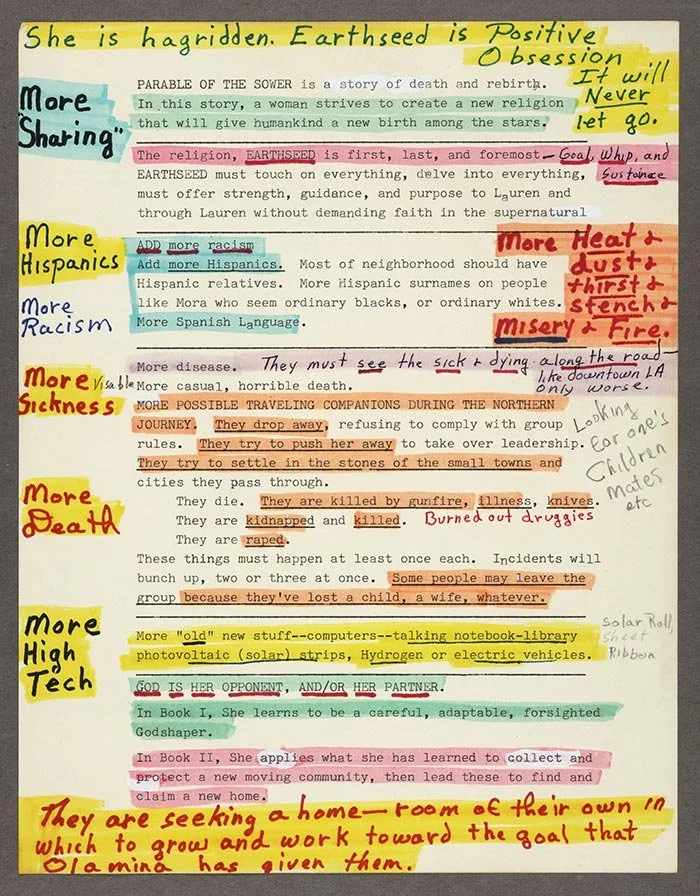Beyond Chrome and Glass: How Black Women Futurists Are Reshaping Tomorrow
When we talk about the future, we often hear the same voices: tech billionaires promising digital utopias, startup founders predicting disruption, white male futurists envisioning chrome-plated tomorrows. But some of the most profound and transformative visions of the future have come from Black women who've long been reimagining what's possible. Their work doesn't just add diversity to the field of futurism – it fundamentally reshapes how we think about the future itself.
Reimagining Time and Possibility
Take Octavia Butler, who didn't just write about the future – she reconstructed the very foundations of how we think about time, power, and possibility. In her work, the future isn't a distant realm of technological salvation. Instead, it's intimately connected to present struggles and past resistance. When Lauren Olamina, the protagonist of Parable of the Sower, declares "God is Change," she's not just making a theological statement – she's articulating a fundamentally different way of understanding transformation.
Outline and notes for Parable of the Sower, ca. 1989. The Huntington Library, Art Collections, and Botanical Gardens. Copyright Estate of Octavia E. Butler.
This approach characterizes much of Black women's futurist work. Writers like Nalo Hopkinson and Nnedi Okorafor don't simply place Black characters in conventional science fiction scenarios. They reimagine the very premises of what futures can look like, drawing on African and Caribbean cosmologies, indigenous knowledge systems, and histories of resistance to create futures that don't replicate current systems of oppression.
While mainstream futurism often focuses obsessively on technology, Black women futurists tend to center different questions: How do communities heal? How do we build new forms of kinship? What does it mean to be truly free? These aren't "soft" questions – they're the fundamental challenges we need to address to create genuinely different futures. adrienne maree brown's work on "emergent strategy" exemplifies this approach. Drawing inspiration from both Octavia Butler and natural systems, she offers ways of thinking about change that don't rely on top-down technological solutions or individual genius inventors. Instead, she focuses on how small-scale interactions and adaptations can create transformative change.
The Present and Future Collapse
What's particularly powerful about Black women's futurism is how it collapses the distance between present and future. Ytasha Womack's work shows how Afrofuturism isn't just about imagining distant tomorrows – it's about recognizing how future-making practices already exist in Black communities. From music to fashion to social organizing, Black women have long been creating futures in the present.
This is evident in the work of artists like Janelle Monáe, whose android alter-ego Cindi Mayweather doesn't just represent a future possibility – she's a tool for understanding and resisting current forms of oppression. Or consider the work of speculative designer Lauren Williams, who creates artifacts from possible futures that challenge our assumptions about power and oppression. These creatives understand that the future isn't something that happens to us – it's something we actively shape through our present practices and imaginations.
Perhaps most importantly, Black women futurists tend to emphasize collective rather than individual futures. While Silicon Valley futurists dream of personal immortality through technology, writers like N.K. Jemisin imagine futures where survival depends on building new forms of community and connection. This isn't coincidental. When you come from communities that have survived through collective resistance and mutual aid, you understand that the future isn't something that happens to isolated individuals. It's something we create together.
Creating New Futures Now
The implications of these approaches extend far beyond literature or art. Organizations like the Octavia Butler Legacy Network and the Black Speculative Arts Movement are creating spaces for Black futures to flourish. Artists, writers, and organizers are using speculative tools to help communities imagine and create the futures they want to see. These aren't marginal or alternative approaches to futurism – they represent some of the most sophisticated thinking about how change happens and how we might create genuinely different futures.
As we face multiple overlapping crises – climate change, racial injustice, economic inequality – we need new ways of imagining and creating futures. Black women futurists offer precisely the kinds of tools and frameworks we need: approaches that emphasize healing, collective action, and fundamental transformation rather than just technological progress. The question isn't just who gets to imagine the future – it's what kinds of futures we're imagining, and how we go about imagining them.
These aren't just theoretical concerns. When we expand our understanding of who can be a futurist and what futurism can look like, we expand our capacity to create real change. Black women's approaches to futurism remind us that the future isn't just about new technologies or scientific breakthroughs. It's about the hard work of imagining and building new ways of being together. The question now is whether we're ready to learn from these traditions and put them into practice.
Want to explore different approaches to imagining and creating futures? Contact us to learn how we can help.
